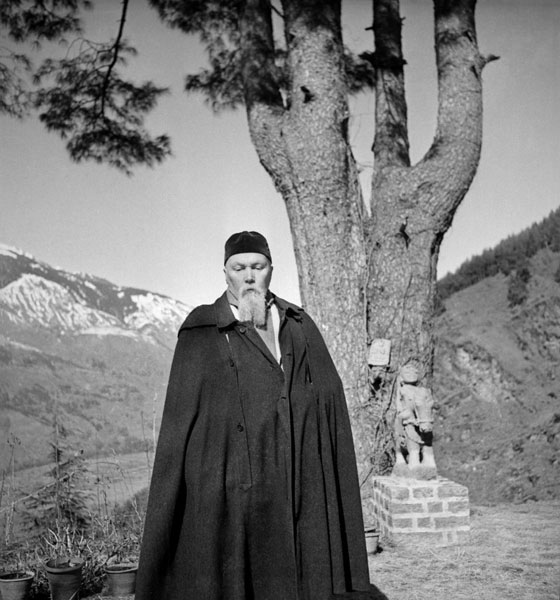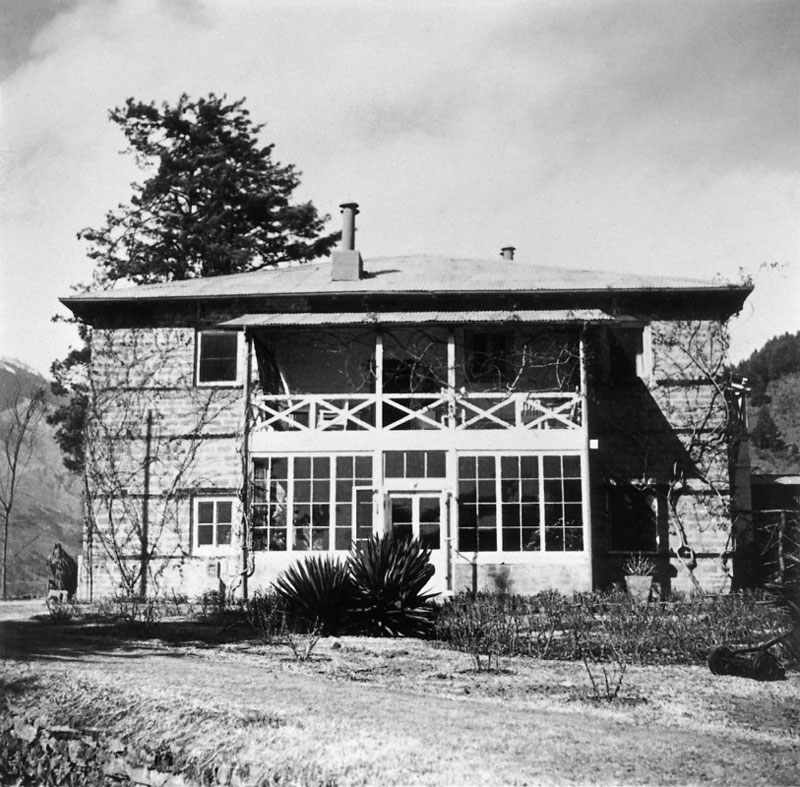| версия для печати | |||
|
|||
Институт «Урусвати»
Институт «Урусвати» | Страницы истории «Урусвати» | Научные исследования в «Урусвати» | Публикации
Научные исследования в Институте «Урусвати» на современном этапе
Опубликовано: Наука в России (Российская академия наук). – 2013. – № 1. – С. 106-112.
Сад в долине Кулу
Светлана ПОТАПОВА , канд. наук. кандидат биологических наук, старший научный
сотрудник Главного ботанического сада
им. Н. Цицина РАН,
ФРОЛОВ Виктор Викторович , д.т.н. кандидат философских наук, заместитель генерального директора
Музея Н. Рериха (Москва)
Наши выдающиеся соотечественники, художник, путешественник и писатель Николай Рерих и его сыновья Святослав-художник и Юрий-востоковед жили и работали в Индии в 1930-1940-е годы. В Наггаре (Куллу) был создан Институт гималайских исследований (Международный научный центр) — Урусвати, который сотрудничал с такими выдающимися учёными разных стран, как Альберт Эйнштейн, Луи де Бройль, Николай Вавилов и другие. В настоящее время усилиями Международного Центра Рерихов (Москва), сотрудников Главного ботанического сада им. Н. Цицина РАН, Зоологического музея МГУ имени М.В. Ломоносова и индийских коллег здесь возрождаются научные исследования. : материалы для данной статьи авторы собрали при изучении растений усадьбы Николая Рериха в Наггаре в 2010-2011 гг. и документов из архива Международного Центра Рерихов.

|

|
|
| Н. Рерих. 1930-е годы. | Вид особняка Н. Рериха в момент его покупки. 1929 год. |
Гималаи – самые высокие горы в мире. В их северо-западной части находится живописная долина Кулу, расположенная в индийском штате Химачал-Прадеш (ее еще называют Долиной 360 богов). Он простирается с севера на юг на протяжении 80 км, то расширяясь до 2-3 км, то сужаясь до узкого каньона. По его дну протекает быстрая река Беас. Вершины окрестных хребтов увенчаны снежными шапками, а склоны покрыты густыми лесами с преобладанием деодарового кедра.
Долина Кулу впервые упоминается в древней Маха-бхарате , персонажи которой начинали свой путь именно оттуда. Когда-то он считался краем света, но с конца 19 века стал курортом, куда британские офицеры возили отдыхать с семьями.
Не случайно именно здесь, в долине Кулу, решил поселиться Николай Рерих. Это место он выбрал после долгих путешествий-экспедиций по Тибету и Гималаям.*
В 1928 году Николай Рерих купил дом в Наггаре, расположенном в 40 км к северу от Кулу, в верховьях долины на высоте почти 2000 м; это простое по архитектуре здание 1880 года постройки раньше принадлежало английскому полковнику. Дом окружен небольшим, но уютным парком**, расположенным на трех террасах западного склона хребта на левом берегу Беаса.
The narrow alley leads to the building under the protection of magnificent Cedrus deodora and Lagerstroemia indica — a multi-trunk high shrub with an umbellate crown. In spring shrubs are covered with thick blossom clusters made of numerous bright-pink double flowers. Hence its local name — Indian pride . In autumn Legerstro-emias blazing like a fire with its bright foliage, contrasting with evergreen branches of neighboring cedars, and look especially striking at night on the background of snowcovered mountains on the other side of Kullu Valley.
The path, leading to the house, is surrounded by an evergreen Euonymus japonica , which forms a hedge. Behind it to the right are big shrubs of Hydraugea macrophylla with enormous caps-blossom clusters of faded-blue flowers. The hedge encircles a triangular front garden, in the center of which one can see two compact trees of Camellia japonica , several shrubs of roses (white and purple), Daphne papyracea and Abutilon sp. To the left from the path, under the age-old cedars, the whole space is planted with Agapanthus umbellatus — a decorative perennial plant from the Liliaceae family with thickened rhizomes and long dark-green lori-form leaves, gathered into a rosette. Its violet flowers on long peduncles are gathered into an umbellate blossom cluster; sometimes the flower number can reach 80! Such attire rises above ground almost 1 m due to long peduncles.

|
S. Roerich in the main part of the park. 1970. |
|
|
N. Roerich and Jawaharlal Neru in the country estate in Naggar. 1942. |

|
|
Opposite the entrance to the estate, on the steep slope one can see Acacia dealbata , well-known in Russia and simply called here mimosa . To the right, near the southern facade of the house, there grow an evergreen, century old, magnificent Magnolia grandiflora and nearby several multitrunk lindens ( Tilia cordata ), brought by the Roerichs from Russia to remember the faraway home-land by. The walls of the building are twined all over by Wisteria schinensis , an evergreen Rosa banksiana with multiflorous bunches of small yellow very fragrant flowers. Among other lianas we can single out Campsis radicans and Jasminum sp.
In front of the western façade, overlooking Kullu Valley, there is also a front garden with a lawn, limited in perimeter by a Japanese spindle-tree hedge. This open space allows to see from the windows a wide panorama of the valley and the river Beas below and majestic ridges of the Himalayas, as if leaning against the sky. The northern part of the terrace, where the mansion is located, is covered with lindens, Ailanthus altissima and shrubs of Hibiscus syriacus . This part of the park is also famous for its Himalayan pine ( Pinus wailichiana ), under which one can see stone statues of local Hinduist gods, collected by Nikolai Roerich (one of them, called Guga Chokhan, a rider on the horse, is depicted in the painter’s pictures). This tree is one of the oldest as well as the tallest in the park, it is 150-200 years old, and 40 m high! By the way, neighboring Deodar cedars are not inferior to the pine in height. The northeastern part of the estate is distinguished for its majestic Cryptomeria japonica — the sole representative of this species in the region.
A rather steep garden staircase with stone steps leads to the next terrace of the park, located lower along the slope. There grow Yucca sellowiana , brought once to the valley by Englishmen and today widely spread in Naggar and its environs. This small terrace, limited by stone breast-walls, is a place, where the house of Svyatoslav and his wife Devica Roerich is located. A short alley, planted all over with shrubs of Lagerstroemia and Buxus sp. leads to it. There are triangular and rectangular front gardens with young shrubs of Buxus sp. in front of the house, and a small open area at the back north side with a beautiful view of the upper reaches of Kullu Valley. Along its edge and on the northern slope there grow Celtias australis , Armeniaca valgaris , Deodar pine, and also shrubs of dogrose and Callicanthus sp.
|
Present-day view of N. Roerich’s |

|
|
|
Garden staircase in the park, |

|
|
A winding paved lane and several garden staircases, traditionally made of local flat stones like slate, lead to the last, lower terrace. The slope proper is planted all over with Diospyrus lotus and apple trees, among which one can single out a sole tree of Sequoiodendron giganteum . Its crown is rather thin: probably in the Himalayan conditions this immigrant from North America does not feel well enough here. On the left side of the slope one can see one of the miracles of the park, though it can be assessed properly only in autumn — in late October-November. It is Prunus cerasoides , a rather big tree, abundantly flowering in autumn without leaves. It is a striking sight: branches covered with beautiful soft-pink flowers on the eve of winter. The plum is also an aboriginal, i.e. a representative of the local Himalayan flora.
This third terrace of the park is the biggest. Eight trees, like the scenes, rise from the eastern side along its entire length in a single row. It is formed by the Himalayan cedar, Deodar pine and linden. In late October, when autumn makes linden crowns golden, one can feel here Russian country estate coloring. As if you were somewhere near Tula or Moscow, not in the Himalayas.
In the center of the area there raises a grey stone, placed at the place of cremation (“samadkhi”— literally “a place of brightening, liberation of the soul”) of Nikolai Roerich. From the terrace you can see practically the whole of Kullu Valley with silver streams of the river below and woody slopes of the mountains, the peaks of which are covered with snow. The picture would not be complete without huge trees of cedar, pine and chestnut, growing lower along the slope, along the periphery of the terrace of the park. All in all, there are growing more then 40 species of trees and shrubs. Flowers are represented by an enormous number of perennial and annual decorative cultures, changing each other in the course of almost a year. In different periods of the year the park is decorated with roses, daffodils, violets, marigold, chrysanthema, plantain lilies, day lilies, gladiola and many other known and unknown plants. According to Svyatoslav Roerich, he used to cultivate even orchids in the garden. On the photos from the archives one can see lilies, peonies and a great number of roses — favorite flowers of Yelena Roerich.
But the park was different before. The old photos of the estate, evidently made at the time of its buying, show how the house and its surroundings looked at that time. The walls were twined all over with Banks Rose and wistaria (on the side of the façade). The fact that these lianas covered the most part of the house, it can be affirmed that they were planted by former owners — Englishmen. On both sides of the main entrance there are seen Spanish daggers. The space around the building was completely open and a greater part was covered with a lawn, which served as a background for a great number of rose shrubs. Nothing obstructed the view of Kullu Valley — the trees of Deodor cedar, growing lower along the slope, were not yet sufficiently tall to close a wonderful view of the environs. Behind the house grew only a four-trunk Himalayan pine, preserved up to the present time. It is a place where the Roerichs and their distinguished guests used to be photographed.

|
| The mountain slope, where N. Roerich’s house is located. |
Besides the park, the country estate also included at that time an adjacent part of the Deodar cedar and Himalayan pine forest, a kitchen-garden and a big orchard with 1,500 fruit trees, including a great number of varieties of apple, peach, cherry, apricot, pear, plum, quince, medlar, chestnut, hazel nut, walnut and grape trees. According to the description of the country estate (from the archives of the International Roerich Center) the fruits were of perfect quality and were highly assessed at local agricultural exhibitions.
Svyatoslav Roerich’s letters contain interesting notes and descriptions of some corners of the park, state of certain plants, changes in the estate territory as well as poetical sketches on the nature of Kullu Valley: “Kullu is beautiful as before, bright colors, very much snow… Many changes have taken place. Indian Pride (above-mentioned Indian lilac. — Auth. ) is cut off, as it was broken by heavy snowfall. Magnolia is now taller than the house, but one side is damaged. Wistaria is in full bloom… I want to plant a thousand apple-trees. Had we done this in 1940-1941, now we would have good results. So, you must not be afraid to improve something you have. The more so as it is so simple.” April 27, 1951. (From the letter to Yelena and Yuri Roerich.)

|

|

|
||
| Southern Magnolia. | Lily of the Nile. | Trunk of Indian lilac. |
“…Now magnolia feels better here, but it is early for flowers. Wistaria was in blossom, and small yellow roses (Banks Rose. — Auth. ). A great number of white daffodils, lilacs, peonies, and roses. Camellia L. has grown. All were in blossom. A lot of orchids, which I have planted 15 years ago, also in blossom. In general, the garden is well preserved.” April 18, 1958. From the letter to Yuri Roerich, Lyudmila and Iraida Bogdanovs. (Bogdanov sisters — assistants and keepers of a part of the heritage of the Roerichs. — Auth. )
“This year Kullu was especially beautiful. The more you travel, the more you become convinced that it is difficult to find more beautiful place. Our trees have grown greatly. Everything is somehow green, shady. Behind the house — linden, on the northern slope — a big vigorous tree. Magnolia in full blossom and has long overgrown the house…” June 29, 1959. From letters to Yuri Roerich, Lyudmila and Iraida Bogdanovs.
“Someday, dear friend, you must come here, to stay here for a while, in order to feel the Spirit of real India and experience the feelings you cherish so greatly. The feelings one cannot express, but which make us live and work, which fill us. …You will be happy to learn that even today hundreds of visitors go up to Naggar to see pictures of the professor Roerich there in the gallery, they make wonderful entries in the visitors’ book, which I intend to publish… I cannot describe the feeling of pacification we feel here, this is an entirely different world, and it seems that it really gives you a new life, and you understand that in fact nothing matters — besides work and admiration of the beauty of these wonderful mountains. These mountains fill with this beauty the people’s soul too. Now the colors are not so delicate as in early spring or autumn, but nonetheless they strike by their remarkable palette… The mountains are in snow, but now, when I am writing, it is raining cats and dogs, and I see how snow falls on the mountains in front of me. Cherries are already ripe, and soon we’ll have all varieties of perfect cherries from our own trees…” May 9, 1964. (From a letter of Devica and Svyatoslav Roerichs to Pavel Belikov.) (P. Belikov — a biographer and researcher of N. Roerich’s works. — Auth. )

|
|
N. Roerich. Guga Chokhan. 1931. |
* See : O. Lavrenova, “Up Hill and Down Dale”, Science in Russia , No. 5, 2011.— Ed.
** Исследования загородного парка, гербария и других биологических коллекций, собранных во многих экспедициях Рерихов в разных районах Средней Азии, Тибета и Гималаев и сегодня хранящихся в институте «Урусвати», проводятся Международным Центром Рериха и сотрудники Главного ботанического сада имени Н. Цицина РАН в рамках программы сохранения и изучения научного и культурного наследия Рерихов в Индии. — Авт .







